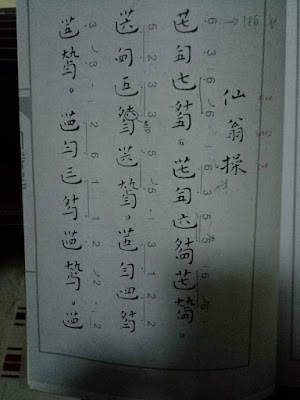“Most of the instruments required in [Chinese] ritual music
have a particular kind of musical notation adapted to the exigencies of their
conformation. For instance, a piece
written for [Qin] presents a complicated combination of strokes difficult to
learn and decipher. Still it is an
ingenious and abbreviated kind of notation.” – J.A. Van Aalst, Chinese Music
I can still
remember sitting in the upstairs music room of my elementary school where the
teacher described a half rest as a top hat and a whole rest as a hole in the
ground. I remember taking up trumpet in
middle school and learning to use a musical instrument to create music
according to such written representations.
I remember joining the jazz band in community college and dedicating
free time during the summer before to learning to read the bass clef, which I
had never needed to know for trumpet, so I could be a proper bassist. All along, I assumed that this was the way
that music was to be written, and never did I imagine that there might be other
systems of recording sounds on paper.
 |
| A piece of Guqin music. |
The system
of writing Guqin music is very fitting to the culture which the instrument
comes from. If someone were to string
together several Chinese words and among them include a single character that
was actually for Guqin musical notation, the western eye would have much
difficulty deciding which was the odd man out.
Despite this, many Chinese people might look at it and be very confused
by the character which they were unable to read. The basic character strokes denoting finger
plucking techniques (right hand) were presented in this post: Characters Representing Right Hand Finger Techniques. These strokes are the foundation upon which
more information is built through a use of radicals, similar to Chinese
orthography, so that each character in the tablature represents one musical
note created through actions of both the right (plucking) and left
(pressing/sliding/tapping) hands. Guqin music is written as Chinese used to be, that is top to bottom and right to left.
There are thirteen inlaid dots
along the top of the body of a Guqin which are used to show the location of
notes, similar to the fretting and inlays on the neck of a guitar. The numbering used to represent these
locations in the tablature naturally use Chinese numbers: 一,二,三,四,五,六,七,八,九,十,十一,十二,十三.
The next
bit that one needs to know is character/radicals which represent the fingers of
the left hand:
 |
| The left hand characters. |
The pinky finger is not used for Guqin, whether on the right
hand or on the left. The character
representing the pointer finger changes to the radical form of 人
when used in musical tablature. For the
ring finger, only the top portion of 名is used (see below).
When
reading a piece of Guqin music, one character made of several radicals
represents one note to be produced. Each
radical tells the player something about how to make the note, e.g., which
finger of the left hand to use, which location to press down on the string, how
to pluck with the right hand, and, of course, which of the seven strings should
be plucked.
Timing is also represented in modern Chinese music, though there was a time when this was not the case, but an explanation of that will be saved for another post.

